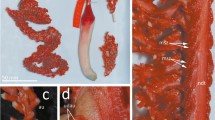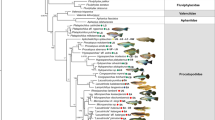Abstract
Phragmatopoma spp. are marine, reef-building polychaetes that inhabit the intertidal and shallow subtidal zones of both coasts of the Americas. Phragmatopoma californica is found in the Pacific Ocean along the California coast south to Mexico, while Phragmatopoma caudata inhabits the Caribbean islands and Atlantic Ocean from the Florida coast south to Brazil. Although apparently geographically isolated, P. californica and P. caudata have been found to interbreed (Pawlik 1988a) and thus their specific taxonomic relationship has been unclear. In this study, two genes, cytochrome c oxidase subunit I (COI) and the first internal transcribed spacer region (ITS-1), were sequenced to assess the specific status of P. californica and P. caudata as well as Phragmatopoma virgini. Comparison of sequences revealed that samples of P. californica shared no COI haplotypes or ITS-1 sequences with P. caudata. Phylogenetic analyses, including maximum parsimony and Bayesian methods, clustered each species in separate, well-supported clades with genetic distances between them being greater than between either contested species or the uncontested, valid species, P. virgini. Thus, the molecular data support that P. californica and P. caudata are separate species. However, the sample of individuals of P. virgini included one genetically divergent individual, whose morphology was found to match that of a species formerly recognized as P. moerchi but since synonymized with P. virgini. Divergences among lineages were dated using the COI sequences, after adjustment for non-clock-like behavior. Consequently, we suggest that P. virgini and P. caudata are sister taxons and that P. californica diverged from the P. virgini/P. caudata clade ∼5.7 mya with P. virgini diverging from P. caudata ∼3 mya.





Similar content being viewed by others
References
Álvarez I, Wendel JF (2003) Ribosomal ITS sequences and plant phylogenetic inference. Mol Phylogenet Evol 29:417–434
Bermingham E, McCafferty SS, Martin AP (1997) Fish biogeography and molecular clocks: perspectives from the Panamanian Isthmus. In: Kocher TDS, C.A. (ed) Molecular systematics of fishes. Academic Press, San Diego, pp 113–128
Brower AVZ (1994) Rapid morphological radiation and convergence among races of the butterfly Heliconius erato inferred from patterns of mitochondrial DNA evolution. Proc Natl Acad Sci USA 91:6491–6495
Burton RS, Rawson PD, Edmands S (1999) Genetic architecture of physiological phenotypes: empitical evidence for coadapted gene complexes. Am Zool 39:451–462
Chen CA, Chen C, Fan T, Yu KJ, Hsieh H (2002) Nucleotide sequences of ribosomal internal transcribed spacers and their utility in distinguishing closely related Perinereis polychaets (Annelida; Polychaeta; Nereididae). Mar Biotechnol 4:17–29
Chen CA, Miller DJ (1996) Analysis of ribosomal ITS1 sequences indicates a deep divergence between Rhodactis (Cnidaria: Anthozoa: Corallimorpharia) species from the Caribbean and the Indo-Pacific Red Sea. Mar Biol 126:423–432
Coates AG, Jackson JBC, Collins LS, Cronin TM, Dowsett HJ, Bybell LM, Jung P, Obando JA (1992) Closure of the Isthmus of Panama: the near-shore marine record of Costa Rica and western Panama. Geol Soc Am Bull 104:814–828
Collins LS, Budd AF, Coates AG (1996) Earliest evolution associated with closure of the Tropical American Seaway. Proc Natl Acad Sci USA 93(12):6069–6072
Daniels SR, Stewart BA, Gouws G, Cunningham M, Matthee CA (2002) Phylogenetic relationships of the southern African freshwater crab fauna (Decapoda: Potamonautidae: Potamonautes) derived from multiple data sets reveal biogeographic patterning. Mol Phylogenet Evol 25:511–523
Duque-Caro H (1990) Neogene stratigraphy, paleoceanography and paleobiogeography in northwest South America and the evolution of the Panama Seaway. Palaeogeog, Palaeoclim, Palaeoecol 77:203–234
Durish ND, Halcomb KE, Kilpatrick CW, Bradley RD (2004) Molecular systematics of the Peromyscus truei species group. J Mammal 85(6):1160–1169
Eckelbarger KJ (1976) Larval Development and population aspects of the reef-building polychaete Phragmatopoma lapidosa Kinberg from the east coast of Florida. Bull Mar Sci 26(2):117–132
Farris JS, Kallersjo M, Kluge AG, Bult C (1994) Testing significance of incongruence. Cladistics 10(3):315–319
Folmer O, Black M, Hoeh W, Lutz R, Vrijenhoek R (1994) DNA primers for amplification of mitochondrial cytochrome c oxidase subunit I from diverse metazoan invertebrates. Mol Mar Biol Biotechnol 3(5):294–299
Fritz GN, Conn J, Cockburn A, Seawright J (1994) Sequence analysis of the ribosomal DNA internal transcribed spacer 2 from populations of Anopheles nuneztovari (Diptera: Culicidae). Mol Biol Evol 11:406–416
Goffredi SK, Hurtado LA, Hallam S, Vrijenhoek RC (2003) Evolutionary relationships of deep-sea vent and cold seep clams (Mollusca: Vesicomyidae) of the “pacifica/lepta” species complex. Mar Biol 142:311–320
Goloboff P (1998) Nona. Computer program and software. Goloboff, P., Tucuman, Argentina
Hartman O (1944) Polychaetous Annelids. Part VI. Paraonidae, Magelonidae, Longosomidae, Ctenodrilidae, and Sabellariidae. Allan Hancock Pacific expeditions 10:311–389, plates 327–342
Hebert PDN, Cywinska A, Ball SL, deWaard JR (2003) Biological identifications through DNA barcodes. Proc Roy Soc London, B 270:313–322
Hebert PDN, Penton EH, Burns JM, Janzen DH, Hallwachs W (2004) Ten species in one: DNA barcoding reveals cryptic species in the neotropical skipper butterfly Astraptes fulgerator. Proc Natl Acad Sci USA 101:14812–14817
Hogg ID, Hebert PDN (2004) Biological identification of springtails (Hexapoda: Collembola) from the Canadian Arctic, using mitochondrial DNA barcodes. Can J Zool 82:749–754
Huelsenbeck JP, Ronquist F (2001) MRBAYES: Bayesian inference of phylogeny. Bioinformatics 17:754–755
Jensen RA, Morse DE (1984) Interspecific facilitation of larval recruitment: gregarious settlement of the polychaete Phragmatopoma californica (Fewkes). J Exp Mar Biol Ecol 83:107–126
Jensen RA, Morse DE (1990) Chemically induced metamorphosis of polychaete larvae in both laboratory and ocean environment. J Chem Ecol 16:911–930
Kirtley DW (1966) Intertidal reefs of sabellaridae, Annelida Polychaeta, along the coast of Florida. Masters Thesis, The Florida State University
Kirtley DW (1994) A review and taxonomic revision of the family Sabellariidae Johnston, 1865 (Annelida; Polychaeta). Sabecon Press-Science Series, Vero Beach, FL
Kimura M (1980) A simple method for estimating evolutionary rate of base substitutions through comparative studies of nucleotide sequences. J Mol Evol 16:111–120
Knowlton N, Weight LA, Solórzano LA, Mills DK, Bermingham E (1993) Divergence in proteins, mitochondrial DNA, and reproductive compatibility across the Isthmus of Panama. Science 260:1629–1632
Ko KS, Jung HS (2002) Three nonorthologous ITS1 types are present in a polypore fungus Trichaptum abietinum. Mol Phylogenet Evol 23:112–122
Kojima S, Ohta S, Yamamoto T, Miura T, Fujiwara Y, Fujikura K, Hashimoto J (2002) Molecular taxonomy of vestimentiferans of the western Pacific and their phylogenetic relationship to species of the easter Pacific. Mar Biol 141:57–64
Kojima S, Ohta S, Yamamoto T, Miura T, Fujiwara Y, Hashimoto J (2001) Molecular taxonomy of vestimentiferans of the western Pacific and their phylogenetic relationship to species of the eastern Pacific. I. Family Lamellibrachiidae. Mar Biol 139:211–219
Kojima S, Segawa R, Hashimoto J, Ohta S (1997) Molecular phylogeny of vestimentiferans collected around Japan, revealed by the nucleotide sequences of mitochondrial DNA. Mar Biol 127:507–513
Lee SB, Taylor JW (1992) Phylogeny of five fungus-like protoctistan Phytophthora species, inferred from the internal transcribed spacers of ribosomal DNA. Mol Biol Evol 9:636–653
Luttikhuizen PC, Drent SJ, Baker AJ (2003) Disjunct distribution of highly diverged mitochondrial lineage clade and population subdivision in a marine bivalve with pelagic larval dispersal. Mol Ecol 12:2215–2229
Mayr E (1942) Systematics and the origin of species. Columbia University Press, New York
McCarthy DA (2001) Life-history patterns and the role of disturbance in intertidal and subtidal populations of the polychaete Phragmatopoma lapidosa lapidosa (Kinberg 1867) in the tropical Western Atlantic. Ph. D. thesis, Kings College, University of London
McCarthy DA, Young CM, Emson RH (2003) Influence of wave-induced disturbance on seasonal spawning patterns in the sabellariid polychaete Phragmatopoma lapidosa. Mar Ecol Prog Ser 256:123–133
Mes THM, Cornelissen AWCA (2004) Non-homogenized ITS regions in the parasitic nematode Cooperia oncophora. Parasitology 129:213–222
Metz EC, Gomez-Gutierrez G, Vacquier VD (1998) Mitochondrial DNA and bindin gene sequence evolution among allopatric species of the sea urchin genus Arbacia. Mol Biol Evol 15:185–195
Nylander JA, Christer AE; Kallersjo M (1999) A test of monophyly of the gutless Phallodrilinae (Oligochaeta, Tubificidae) and the use of a 573-bp region of the mitochondrial cytochrome oxidase I gene in analysis of annelid phylogeny. Zool Scr 28:305–313
Page RDM (1996) TREEVIEW: An application to display phylogenetic trees on personal computers. Comp App Biosci 12:357–358
Parkin EJ, Butlin RK (2004) Within- and Between-Individual sequence variation among ITS1 copies in the meadow grasshopper Chorthippus parallelus indicates frequent intrachromosomal gene conversion. Molecular Biology and Evolution 21:1595–1601
Pawlik JR (1986) Chemical induction of larval settlement and metamorphosis in the reef-building tube worm Phragmatopoma californica (Polychaeta: Sabellariidae). Mar Biol 91:59–68
Pawlik JR (1988a) Larval settlement and metamorphosis of sabellariid polychaetes, with special reference to Phragmatopoma lapidosa, a reef-building species, and Sabellaria floridensis, a non-gregarious species. Bull Mar Sci 43:41–60
Pawlik JR (1988b) Larval settlement and metamorphosis of two gregarious sabellariid polychaetes: Sabellaria alveolata compared with Phragmatopoma californica. J Mar Biol Ass. U.K. 68:101–124
Pawlik JR, Butman CA, Starczak VR (1991) Hydrodynamic facilitation of gregarious settlement in a reef-building tube worm. Science 251:421–423
Pawlik JR, Faulkner DJ (1986) Specific free fatty acids induce larval settlement and metamorphosis of the reef-building tube worm Phragmatopoma californica (Fewkes). J Exp Mar Biol Ecol 102:301–310
Pawlik JR, Mense DJ (1994) Larval transport, food limitation, ontogenetic plasticity, and the recruitment of sabellariid polycheates. In: Wilson Jr WH, Stricker SA, Shinn GL (eds) Reproduction and Development of Marine Invertebrates, The J. John Hopkins University Press, Baltimore, MD pp 275–286
Pfeiler E, Hurtado LA, Knowles LL, Torre-Cosío J, Bourillón-Moreno L, Márquez-Farías JF, Montemayor-López G (2005) Population genetics of the swimming crab Callinectes bellicosus (Brachyura: Portunidae) from the eastern Pacific Ocean. Mar Biol 146:559–569
Pilgrim EM, Roush SA, Krane DE (2002) Combining DNA sequences and morphology in systematics: testing the validity of the dragonfly species Cordulegaster bilineata. Heredity 89:184–190
Posada D, Crandall KA (1998) MODELTEST: testing the model of DNA substitution. Bioinformatics 14(9):817–818
Rawson PD, Burton RS (2002) Functional coadaption between cytochrome c and cytochrome c oxidase within allopatric populations of a marine copepod. Proc Natl Acad Sci USA 99:12955–12958
Sanderson MJ (2002) r8S, version 1.05 (beta) user’s manual. Univ. of California, Davis, CA
Schlötterer C, Hauser M-T, von Haeseler A, Tautz D (1994) Comparative evolutionary analysis of rDNA ITS regions in Drosophila. Mol Biol Evol 11:513–522
Siddall ME, Burreson EM (1998) Phylogeny of leeches (Hirudinea) based on mitochondrial cytochrome c oxidase subunit I. Mol Phylogenet Evol 9:156–162
Simmons SA, Zimmer RK, Zimmer CA (2005) Life in the lee: local distributions and orientations of honeycomb worms along the California coast. J Mar Res 63(3):623–643
Swofford DL (2001) PAUP*: phylogenetic analysis using parsimony (*and other methods). Version 4.0b8. Sinauer, Sunderland, MA
Thomas FIM (1994) Transport and mixing of gametes in three free-spawning polychaete annelids, Phragmatopoma californica (Fewkes), Sabellaria cementarium (Moore), and Schizobranchia insignis (Bush). J Exp Mar Biol Ecol 179:11–27
Thompson JD, Higgins DG, Gibson TJ (1994) Clustal-W-Improving the sensitivity of progressive multiple sequence alignment through sequence weighting, position-specific gap penalties and weight matrix choice. Nucleic Acids Res 22:4673–4680
Vogler AP, DeSalle R (1994) Evolution and phylogenetic information content of the ITS-1 region in the tiger beetle Cicindela dorsalis. Mol Biol Evol 11:393–405
Wörheide G, Nichols SA, Goldberg J (2004) Intragenomic variation of the rDNA internal transcribed spacers in sponges (Phylum Porifera): implications for phylogenetic studies. Mol Phylogenet Evol 33:816–830
Acknowledgments
The authors would like to especially thank Melissa Wilson, Victor Gallardo, Rachel Collin, and John Pearse for collecting the majority of the worms. We would also like to thank Joe Pawlik for the research idea for this project. We would also like to thank Erik Pilgrim for assistance with manuscript preparation. Experiments comply with the current laws of the United States. This is FTPSMS contribution number 644.
Author information
Authors and Affiliations
Corresponding author
Additional information
Communicated by P.W. Sammarco, Chauvin
Rights and permissions
About this article
Cite this article
Drake, C.A., McCarthy, D.A. & von Dohlen, C.D. Molecular relationships and species divergence among Phragmatopoma spp. (Polychaeta: Sabellaridae) in the Americas. Mar Biol 150, 345–358 (2007). https://doi.org/10.1007/s00227-006-0373-6
Received:
Accepted:
Published:
Issue Date:
DOI: https://doi.org/10.1007/s00227-006-0373-6




